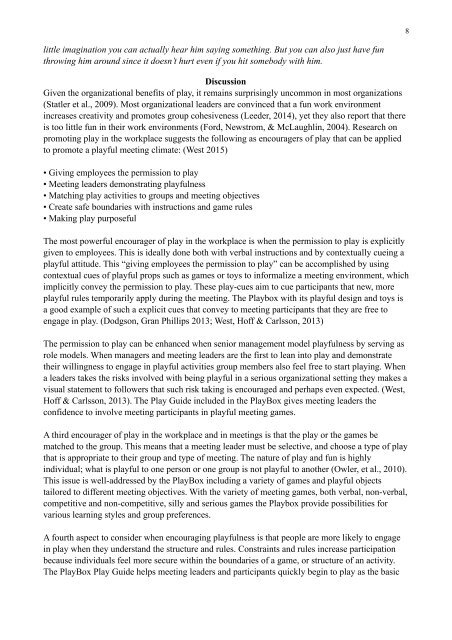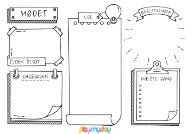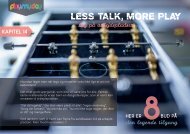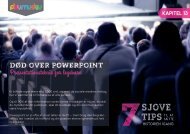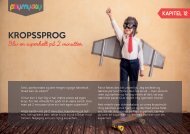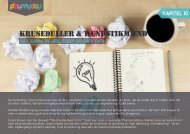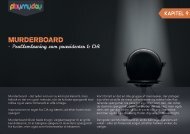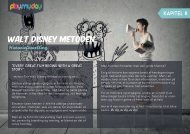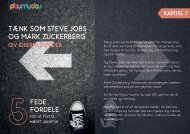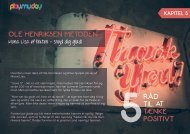PlayMyDay_report2
Play My Day report - a litterature review of the benefits of play in the workplace and qualitative pi,ot study of Playbox by Koncept Kompagniet
Play My Day report - a litterature review of the benefits of play in the workplace and qualitative pi,ot study of Playbox by Koncept Kompagniet
Create successful ePaper yourself
Turn your PDF publications into a flip-book with our unique Google optimized e-Paper software.
!8<br />
little imagination you can actually hear him saying something. But you can also just have fun<br />
throwing him around since it doesn’t hurt even if you hit somebody with him.<br />
Discussion<br />
Given the organizational benefits of play, it remains surprisingly uncommon in most organizations<br />
(Statler et al., 2009). Most organizational leaders are convinced that a fun work environment<br />
increases creativity and promotes group cohesiveness (Leeder, 2014), yet they also report that there<br />
is too little fun in their work environments (Ford, Newstrom, & McLaughlin, 2004). Research on<br />
promoting play in the workplace suggests the following as encouragers of play that can be applied<br />
to promote a playful meeting climate: (West 2015)<br />
• Giving employees the permission to play<br />
• Meeting leaders demonstrating playfulness<br />
• Matching play activities to groups and meeting objectives<br />
• Create safe boundaries with instructions and game rules<br />
• Making play purposeful<br />
The most powerful encourager of play in the workplace is when the permission to play is explicitly<br />
given to employees. This is ideally done both with verbal instructions and by contextually cueing a<br />
playful attitude. This “giving employees the permission to play” can be accomplished by using<br />
contextual cues of playful props such as games or toys to informalize a meeting environment, which<br />
implicitly convey the permission to play. These play-cues aim to cue participants that new, more<br />
playful rules temporarily apply during the meeting. The Playbox with its playful design and toys is<br />
a good example of such a explicit cues that convey to meeting participants that they are free to<br />
engage in play. (Dodgson, Gran Phillips 2013; West, Hoff & Carlsson, 2013)<br />
The permission to play can be enhanced when senior management model playfulness by serving as<br />
role models. When managers and meeting leaders are the first to lean into play and demonstrate<br />
their willingness to engage in playful activities group members also feel free to start playing. When<br />
a leaders takes the risks involved with being playful in a serious organizational setting they makes a<br />
visual statement to followers that such risk taking is encouraged and perhaps even expected. (West,<br />
Hoff & Carlsson, 2013). The Play Guide included in the PlayBox gives meeting leaders the<br />
confidence to involve meeting participants in playful meeting games.<br />
A third encourager of play in the workplace and in meetings is that the play or the games be<br />
matched to the group. This means that a meeting leader must be selective, and choose a type of play<br />
that is appropriate to their group and type of meeting. The nature of play and fun is highly<br />
individual; what is playful to one person or one group is not playful to another (Owler, et al., 2010).<br />
This issue is well-addressed by the PlayBox including a variety of games and playful objects<br />
tailored to different meeting objectives. With the variety of meeting games, both verbal, non-verbal,<br />
competitive and non-competitive, silly and serious games the Playbox provide possibilities for<br />
various learning styles and group preferences.<br />
A fourth aspect to consider when encouraging playfulness is that people are more likely to engage<br />
in play when they understand the structure and rules. Constraints and rules increase participation<br />
because individuals feel more secure within the boundaries of a game, or structure of an activity.<br />
The PlayBox Play Guide helps meeting leaders and participants quickly begin to play as the basic


